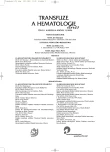The use of alemtuzumab in allogeneic stem cell transplantation
Využití alemtuzumabu u transplantací krvetvorných buněk
Alogenní transplantace krvetvorných buněk využívá schopnosti imunitních buněk dárce, T lymfocytů, ničit nádorové nebo leukemické buňky hostitele. Současně T lymfocyty dárce působí negativně proti zdravým tkáním hostitele. V posledním desetiletí dominuje použití periferních kmenových buněk u alogenních transplantací krvetvorných buněk, což na jedné straně znamená rychlejší přihojení štěpu a sníženou frekvenci relapsů nemoci, ale na druhé straně také vyšší frekvenci akutní a chronické reakce štěpu proti hostiteli. Začaly se používat některé další postupy, které významně rozšiřují možnosti indikace alogenních transplantací: 1. transplantace s redukovanou intenzitou přípravného režimu s cílem minimalizace toxických účinků chemoterapie nebo chemoradioterapie, kde dominantní antitumorózní efekt zprostředkují dárcovské T lymfocyty; 2. podání dárcovské leukocytární infuze k posílení reakce štěpu proti nádoru, proti leukemii. Reakce štěpu proti nádoru je vždy spjata s reakcí štěpu proti hostiteli. Monoklonální protilátka Campath 1 byla vyvinuta k odstranění T lymfocytů z dárcovského štěpu. V současnosti je komerčně dostupná humanizovaná protilátka alemtuzumab s variabilní krysí částí, ostatní části molekuly jsou lidské. Snižuje intenzitu reakce štěpu proti hostiteli, zvyšuje však frekvenci relapsů a infekcí. Alemtuzumab je využíván s různými druhy chemo - či chemoradioterapie, přesných dat je v současnosti relativně málo. Kromě druhu přípravného režimu je důležitá dávka a způsob podání alemtuzumabu: 1. parenterální podání pacientovi má antitumorózní efekt, imunosupresivní efekt na buňky příjemce a může také způsobit depleci T lymfocytů v transplantátu 2. podání alemtuzumabu přímo do transplantátu s efektem T deplece. Kromě peritransplantačního podání alemtuzumabu je možnost jeho využití také v terapii rozvinuté reakce štěpu proti hostiteli, ale dat je zatím velmi málo.
Klíčová slova:
alogenní transplantace krvetvorných buněk, reakce štěpu proti hostiteli, imunosuprese, Campath, alemtuzumab
Authors:
J. Mayer; Y. Brychtová
Authors‘ workplace:
Interní hematoonkologická klinika FN Brno
Published in:
Transfuze Hematol. dnes,12, 2006, No. 1, p. 14-19.
Category:
Comprehensive Reports, Original Papers, Case Reports
Overview
Allogeneic stem cell transplantation takes advantage of donor immunocompetent T lymphocytes to have an antimalignancy or antileukaemic effect, however which is associated with graft versus host effect generally. The allogeneic transplantations of peripheral blood stem cells are overbearing in the last ten years, which induce faster engraftment and fewer relapses of disease, while acute and chronic graft versus host disease are more frequent. There are new ways that significantly increase the indication of allogeneic stem cell transplantation: 1. transplantation with reduced intensity conditioning to decrease toxicity chemo or chemoradiotherapy, when the donor T lymphocytes have the major antimalignancy effect; 2. donor leukocytes infusion to intensification of antimalignancy effect. Monoclonal antibody Campath 1 was developed for clearence T lymphocytes from donor graft. On the present time there is available the humanised anti-CD 52 antibody alemtuzumab, which have the rat variable part of immunoglobuline and other parts are human. The usage of alemtuzumab during alogeneic stem cell transplantation drop intensity of graft versus host disease, while relapses and infections are more often. There are not a lot of data about results of combination alemtuzumab with chemo and chemoradiotherapy. The way of alemtuzumab is important for its effect: 1. intravenous administration has antimalignant effect and immunosupressive effect to host cells and might make depletion of T lymphocytes in the graft; 2. administration into the bag with donor graft makes only depletion of T lymphocytes. Alemtuzumab is useful for treatment of developed graft versus host disease, but there are a few data so far.
Key words:
allogeneic stem cell transplantation, graft versus host disease, immunosuppression, Campath, alemtuzumab
Labels
Haematology Internal medicine Clinical oncologyArticle was published in
Transfusion and Haematology Today

2006 Issue 1
- What FVIII Levels Are Ideal for Preventing Bleeding in Hemophilia A?
- Cost Effectiveness of FVIII Substitution Versus Non-Factor Therapy for Hemophilia A
- Vascular Disease in the Gradually Aging Population of Hemophiliacs: An Underestimated Problem?
- Prognostic Significance of Subclinical Joint Changes on MRI in Hemophilia
- Immunotolerance is still the goal of management of hemophilia A with inhibitor in the era of non-factor therapy
Most read in this issue
- Real cost of chronic myeloid leukemia treatment with nonmyeloablative hematopoietic stem cell transplantation and comparison with cost of hypothetical imatinib treatment. What shall be considered in the cases of extremely costly medical procedures?
- Transmission of prion disease by blood and hot news in detection methods of abnormal prion protein
- Immunophenotyping of childhood leukaemias
- The use of alemtuzumab in allogeneic stem cell transplantation
